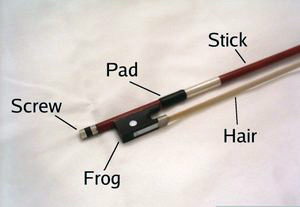A bow is a device pulled across the strings of an instrument, which in turn makes them vibrate and create sound. The type of bow used to play instruments in the violin family (violin, viola, cello, and double bass) typically consists of a stick of wood with strands of horse hair stretched between each end. There are many types of wood that can be used, but many of the finest bows are made of Pernambuco wood from Brazil. Synthetic bows can be made from carbon-fiber or other man-made materials. The end of the bow has a place hold the bow, called a "frog". The frog is generally made from ebony wood with silver, gold, ivory, pearl shell, or tortoise shell for decoration.
A bow maker uses about 150 hairs for each bow. Cheaper bows may use nylon or synthetic hair instead of horse hair. Rosin, a sticky substance made from tree sap, is regularly applied to the bow hair so that the bow moving across the instrument's strings will cause the string to vibrate and produce the sound. When the player pulls the bow across the strings, it is called a down-bow; pushing in the direction of the tip is an up-bow. Generally, the down-bow stroke is used for strong musical beats, and the up-bow for weak beats. Playing an instrument by touching the strings with the wood of the bow rather than the hair is known by the Italian phrase col legno. Arco in Italian is the indication to use the bow hair to create the sound.

Origin of the Bow
When and where the bow was invented is not entirely clear. Scholars are agreed that stringed instruments existed long before the bow. There was a long period—possibly thousands of years—in which all stringed instruments were plucked like a guitar.
In fact, it is likely that bowed instruments are not much more than a thousand years old. Eric Halfpenny says "bowing can be traced as far back as the Islamic civilization of the 10th century ... it seems likely that the principle of bowing originated among the horse cultures of Central Asia, whence it spread quickly through Islam and the East, so that by 1000 it had almost simultaneously reached China, Java, North Africa, the Near East and Balkans, and Europe." (1988 Encyclopedia Britannica) Halfpenny notes that in many Eurasian languages the word for “bridge” etymologically means "horse," and that the Chinese regarded their own bowed instruments as having originated with the "barbarians" of Central Asia.
The Central Asian theory is endorsed by Werner Bachmann, writing in the New Grove. Bachmann notes evidence from a tenth century Central Asian wall painting for bowed instruments in what is now the city of Kurbanshaid in Tajikistan. Circumstantial evidence also supports the Central Asian theory. All the elements that were necessary for the invention of the bow were probably present among the Central Asian horse peoples at the same time:
- In a society of horse-mounted warriors (the horse peoples included the Huns and the Mongols), horsehair obviously would have been available.
- Central Asian horse warriors specialized in the military bow, which could easily have served the inventor as a temporary way to hold horsehair at high tension.
- To this day, horsehair for bows is taken from horses in northern climates, since such hair provides more friction.
- Rosin, crucial for creating sound even with coarse horsehair, is used by traditional archers to maintain the integrity of the string and (mixed with beeswax) to protect the finish of the bow
From all this it is tempting to imagine the invention of the bow by some Mongol warrior, having just used rosin on his equipment, idly stroked his harp or lyre with a rosin-dusted finger and produced a brief continuous sound, which caused him to have an inspiration; whereupon he seized his bow, restrung it with horsehair, and so on. Obviously, the degree to which this fantasy is true will never be known.
However the bow was invented, it soon spread very widely. The Central Asian horse peoples occupied a territory that included the famous Silk Road, along which goods and innovations were shipped rapidly for thousands of miles (including, via India, by sea to Java). This would account for the near-simultaneous appearance of the musical bow in the many locations cited by Halfpenny.
The Modern Violin Bow
The kind of bow in use today was brought into its modern form largely by the bow-maker François Tourte in 19th century France. Pernambuco wood which was imported into France to make textile dye, was found by the early French bow masters to have just the right combination of strength, resiliency, weight, and beauty. Even so, a violin or a bow maker must choose sound quality above all, when choosing wood to make bows and instruments. A common practice even today, is to reserve the best and most beautiful tone wood for bows and instruments for a makers most expensive works. In order to shape the curve or “cambre” of the bow stick, a maker must first carve and then gradually heat the stick. A metal or wooden template is used to get the exact models curve and shape while heating. The art of bow making has changed little since the 19th century. The image above shows a modern violin bow. Turning the screw causes the frog to move, which adjusts the tension on the hair. For more information, see this page on the parts of the bow.

